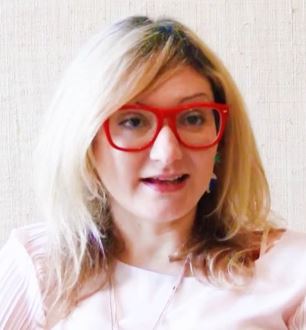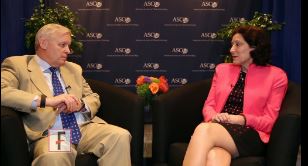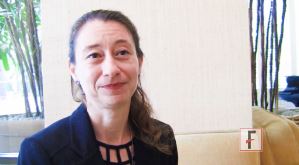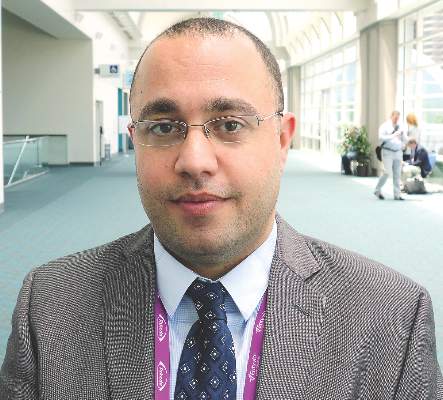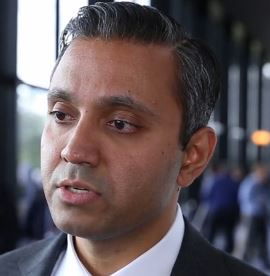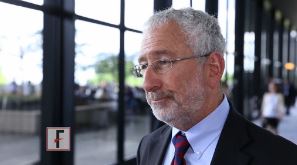User login
VIDEO: The ins and outs of JAK ihibitors for alopecia
NEWPORT BEACH, CALIF. – The promise of Janus kinase (JAK) inhibitors for alopecia seems to be holding up in the practice of Dr. Natasha Mesinkovska, a dermatologist at the University of California, Irvine.
There’s been much excitement about JAK inhibitors since Yale researchers reported in 2014 that tofacitinib (Xeljanz), a JAK inhibitor approved in the United States for rheumatoid arthritis, appeared to grow a full head of hair, plus body hair, in an essentially hairless 25-year-old man with plaque psoriasis. JAK inhibitors have been under investigation for alopecia ever since. Meanwhile, they are being used off label for hair loss around the country.
In her own practice, Dr. Mesinkovska estimates that about two-thirds of patients have some degree of hair regrowth, with particularly satisfying results in men. About 40 of her alopecia patients have opted for JAK inhibitors so far.
In an interview at the Summit in Aesthetic Medicine, Dr. Mesinkovska shared her insights and tips, as well as promising alopecia results for the psoriasis biologic ustekinumab (Stelara), an interleukin-12 and -23 antagonist. “This is a very exciting time for alopecia areata,” she said.
The Summit in Aesthetic Medicine is held by the Global Academy for Medical Education. Global Academy and this news organization are owned by the same company.
The video associated with this article is no longer available on this site. Please view all of our videos on the MDedge YouTube channel
NEWPORT BEACH, CALIF. – The promise of Janus kinase (JAK) inhibitors for alopecia seems to be holding up in the practice of Dr. Natasha Mesinkovska, a dermatologist at the University of California, Irvine.
There’s been much excitement about JAK inhibitors since Yale researchers reported in 2014 that tofacitinib (Xeljanz), a JAK inhibitor approved in the United States for rheumatoid arthritis, appeared to grow a full head of hair, plus body hair, in an essentially hairless 25-year-old man with plaque psoriasis. JAK inhibitors have been under investigation for alopecia ever since. Meanwhile, they are being used off label for hair loss around the country.
In her own practice, Dr. Mesinkovska estimates that about two-thirds of patients have some degree of hair regrowth, with particularly satisfying results in men. About 40 of her alopecia patients have opted for JAK inhibitors so far.
In an interview at the Summit in Aesthetic Medicine, Dr. Mesinkovska shared her insights and tips, as well as promising alopecia results for the psoriasis biologic ustekinumab (Stelara), an interleukin-12 and -23 antagonist. “This is a very exciting time for alopecia areata,” she said.
The Summit in Aesthetic Medicine is held by the Global Academy for Medical Education. Global Academy and this news organization are owned by the same company.
The video associated with this article is no longer available on this site. Please view all of our videos on the MDedge YouTube channel
NEWPORT BEACH, CALIF. – The promise of Janus kinase (JAK) inhibitors for alopecia seems to be holding up in the practice of Dr. Natasha Mesinkovska, a dermatologist at the University of California, Irvine.
There’s been much excitement about JAK inhibitors since Yale researchers reported in 2014 that tofacitinib (Xeljanz), a JAK inhibitor approved in the United States for rheumatoid arthritis, appeared to grow a full head of hair, plus body hair, in an essentially hairless 25-year-old man with plaque psoriasis. JAK inhibitors have been under investigation for alopecia ever since. Meanwhile, they are being used off label for hair loss around the country.
In her own practice, Dr. Mesinkovska estimates that about two-thirds of patients have some degree of hair regrowth, with particularly satisfying results in men. About 40 of her alopecia patients have opted for JAK inhibitors so far.
In an interview at the Summit in Aesthetic Medicine, Dr. Mesinkovska shared her insights and tips, as well as promising alopecia results for the psoriasis biologic ustekinumab (Stelara), an interleukin-12 and -23 antagonist. “This is a very exciting time for alopecia areata,” she said.
The Summit in Aesthetic Medicine is held by the Global Academy for Medical Education. Global Academy and this news organization are owned by the same company.
The video associated with this article is no longer available on this site. Please view all of our videos on the MDedge YouTube channel
EXPERT ANALYSIS FROM THE SUMMIT IN AESTHETIC MEDICINE
VIDEO: Dr. William A. Gradishar and Dr. Hope S. Rugo discuss #ASCO16
CHICAGO – Do anthracyclines still have a role in treating breast cancer? What are the implications for resistance of extending adjuvant aromatase inhibitors to 10 years or beyond? How best to treat women with metastatic hormone receptor–positive breast cancer, in light of findings on CDK 4/6 and mTOR inhibitors? Does sequence matter? In the case of HER2-positive disease, can a trastuzumab biosimilar be as effective as trastuzumab? And does a regimen with TDM-1 do more than reduce toxicity?
Dr. William A. Gradishar and Dr. Hope S. Rugo reflect on these questions and more in a video roundtable at the annual meeting of the American Society of Clinical Oncology.
Dr. William A. Gradishar is the Betsy Bramsen Professor of Breast Oncology at Northwestern University, Chicago. He had no disclosures to report. Dr. Hope S. Rugo is professor of medicine at the University of California, San Francisco. She disclosed she is on the Speakers’ Bureau for Genomic Health and receives research funding (institutional) from Plexxikon, Macrogenics, OBI Pharma, Eisai, Pfizer, Novartis, Lilly, GlaxoSmithKline, Genentech, Celsion, Nektar, and Merck.
The video associated with this article is no longer available on this site. Please view all of our videos on the MDedge YouTube channel
lnikolaides@frontlinemedcom.com
On Twitter @NikolaidesLaura
CHICAGO – Do anthracyclines still have a role in treating breast cancer? What are the implications for resistance of extending adjuvant aromatase inhibitors to 10 years or beyond? How best to treat women with metastatic hormone receptor–positive breast cancer, in light of findings on CDK 4/6 and mTOR inhibitors? Does sequence matter? In the case of HER2-positive disease, can a trastuzumab biosimilar be as effective as trastuzumab? And does a regimen with TDM-1 do more than reduce toxicity?
Dr. William A. Gradishar and Dr. Hope S. Rugo reflect on these questions and more in a video roundtable at the annual meeting of the American Society of Clinical Oncology.
Dr. William A. Gradishar is the Betsy Bramsen Professor of Breast Oncology at Northwestern University, Chicago. He had no disclosures to report. Dr. Hope S. Rugo is professor of medicine at the University of California, San Francisco. She disclosed she is on the Speakers’ Bureau for Genomic Health and receives research funding (institutional) from Plexxikon, Macrogenics, OBI Pharma, Eisai, Pfizer, Novartis, Lilly, GlaxoSmithKline, Genentech, Celsion, Nektar, and Merck.
The video associated with this article is no longer available on this site. Please view all of our videos on the MDedge YouTube channel
lnikolaides@frontlinemedcom.com
On Twitter @NikolaidesLaura
CHICAGO – Do anthracyclines still have a role in treating breast cancer? What are the implications for resistance of extending adjuvant aromatase inhibitors to 10 years or beyond? How best to treat women with metastatic hormone receptor–positive breast cancer, in light of findings on CDK 4/6 and mTOR inhibitors? Does sequence matter? In the case of HER2-positive disease, can a trastuzumab biosimilar be as effective as trastuzumab? And does a regimen with TDM-1 do more than reduce toxicity?
Dr. William A. Gradishar and Dr. Hope S. Rugo reflect on these questions and more in a video roundtable at the annual meeting of the American Society of Clinical Oncology.
Dr. William A. Gradishar is the Betsy Bramsen Professor of Breast Oncology at Northwestern University, Chicago. He had no disclosures to report. Dr. Hope S. Rugo is professor of medicine at the University of California, San Francisco. She disclosed she is on the Speakers’ Bureau for Genomic Health and receives research funding (institutional) from Plexxikon, Macrogenics, OBI Pharma, Eisai, Pfizer, Novartis, Lilly, GlaxoSmithKline, Genentech, Celsion, Nektar, and Merck.
The video associated with this article is no longer available on this site. Please view all of our videos on the MDedge YouTube channel
lnikolaides@frontlinemedcom.com
On Twitter @NikolaidesLaura
EXPERT ANALYSIS FROM THE 2016 ASCO ANNUAL MEETING
VIDEO: How to treat vascular birthmarks
NEWPORT BEACH, CALIF. – A combination of propranolol and laser is more effective than propranolol alone for infantile hemangiomas, and rapamycin can improve pulse die laser results for port wine stains.
Meanwhile, lasers hurt, so general anesthesia is in order for children as long as they’re older than 6 months.
Those are just a few of the pearls Dr. Kristen Kelly, a University of California, Irvine, professor of dermatology and surgery, shared at the Summit in Aesthetic Medicine. Dr. Kelly explained the latest developments in an interview at the conference, held by Global Academy for Medical Education.
Global Academy and this news organization are owned the same company.
The video associated with this article is no longer available on this site. Please view all of our videos on the MDedge YouTube channel
NEWPORT BEACH, CALIF. – A combination of propranolol and laser is more effective than propranolol alone for infantile hemangiomas, and rapamycin can improve pulse die laser results for port wine stains.
Meanwhile, lasers hurt, so general anesthesia is in order for children as long as they’re older than 6 months.
Those are just a few of the pearls Dr. Kristen Kelly, a University of California, Irvine, professor of dermatology and surgery, shared at the Summit in Aesthetic Medicine. Dr. Kelly explained the latest developments in an interview at the conference, held by Global Academy for Medical Education.
Global Academy and this news organization are owned the same company.
The video associated with this article is no longer available on this site. Please view all of our videos on the MDedge YouTube channel
NEWPORT BEACH, CALIF. – A combination of propranolol and laser is more effective than propranolol alone for infantile hemangiomas, and rapamycin can improve pulse die laser results for port wine stains.
Meanwhile, lasers hurt, so general anesthesia is in order for children as long as they’re older than 6 months.
Those are just a few of the pearls Dr. Kristen Kelly, a University of California, Irvine, professor of dermatology and surgery, shared at the Summit in Aesthetic Medicine. Dr. Kelly explained the latest developments in an interview at the conference, held by Global Academy for Medical Education.
Global Academy and this news organization are owned the same company.
The video associated with this article is no longer available on this site. Please view all of our videos on the MDedge YouTube channel
EXPERT ANALYSIS FROM THE SUMMIT IN AESTHETIC MEDICINE
VIDEO: Endoscopic pyloromyotomy works for gastroparesis when meds don’t
SAN DIEGO – Gastric peroral endoscopic myotomy, a novel procedure for gastroparesis, restored gastric emptying in 30 refractory patients at Johns Hopkins University, Baltimore, and elsewhere in the largest series to date for the technique.
Drug therapy had failed, and Botox injections and transpyloric stenting weren’t helping much. On gastric emptying scans (GES), patients had around 40% of solid meals in their stomachs at 4 hours. Their gastroparesis was related mostly to diabetes and postoperative complications, but about a quarter of the cases were idiopathic.
Twenty-six patients (87%) responded to gastric peroral endoscopic myotomy (G-POEM) during a median follow-up of 5.5 months. Nausea, vomiting, and abdominal pain resolved or improved in most. On repeat GES in 17 patients, emptying time normalized in about half and improved in a third. Overall, patients had 17% of solid meals in their stomachs at 4 hours. G-POEM took an average of 72 minutes, and patients were in the hospital for about 3 days. One patient in the series developed pneumoperitoneum, and another had a prepyloric ulcer.
“The problem with transpyloric stents is that they migrate,” said investigator Dr. Mouen A. Khashab, director of therapeutic endoscopy at Johns Hopkins University. “G-POEM offers a permanent solution with few side effects. You have to be good at doing POEM in the esophagus first, as a prerequisite.”
In an interview at the annual Digestive Disease Week, Dr. Khashab explained the procedure in detail, as well as how he incorporates it into his practice and the patient population most likely to benefit.
SAN DIEGO – Gastric peroral endoscopic myotomy, a novel procedure for gastroparesis, restored gastric emptying in 30 refractory patients at Johns Hopkins University, Baltimore, and elsewhere in the largest series to date for the technique.
Drug therapy had failed, and Botox injections and transpyloric stenting weren’t helping much. On gastric emptying scans (GES), patients had around 40% of solid meals in their stomachs at 4 hours. Their gastroparesis was related mostly to diabetes and postoperative complications, but about a quarter of the cases were idiopathic.
Twenty-six patients (87%) responded to gastric peroral endoscopic myotomy (G-POEM) during a median follow-up of 5.5 months. Nausea, vomiting, and abdominal pain resolved or improved in most. On repeat GES in 17 patients, emptying time normalized in about half and improved in a third. Overall, patients had 17% of solid meals in their stomachs at 4 hours. G-POEM took an average of 72 minutes, and patients were in the hospital for about 3 days. One patient in the series developed pneumoperitoneum, and another had a prepyloric ulcer.
“The problem with transpyloric stents is that they migrate,” said investigator Dr. Mouen A. Khashab, director of therapeutic endoscopy at Johns Hopkins University. “G-POEM offers a permanent solution with few side effects. You have to be good at doing POEM in the esophagus first, as a prerequisite.”
In an interview at the annual Digestive Disease Week, Dr. Khashab explained the procedure in detail, as well as how he incorporates it into his practice and the patient population most likely to benefit.
SAN DIEGO – Gastric peroral endoscopic myotomy, a novel procedure for gastroparesis, restored gastric emptying in 30 refractory patients at Johns Hopkins University, Baltimore, and elsewhere in the largest series to date for the technique.
Drug therapy had failed, and Botox injections and transpyloric stenting weren’t helping much. On gastric emptying scans (GES), patients had around 40% of solid meals in their stomachs at 4 hours. Their gastroparesis was related mostly to diabetes and postoperative complications, but about a quarter of the cases were idiopathic.
Twenty-six patients (87%) responded to gastric peroral endoscopic myotomy (G-POEM) during a median follow-up of 5.5 months. Nausea, vomiting, and abdominal pain resolved or improved in most. On repeat GES in 17 patients, emptying time normalized in about half and improved in a third. Overall, patients had 17% of solid meals in their stomachs at 4 hours. G-POEM took an average of 72 minutes, and patients were in the hospital for about 3 days. One patient in the series developed pneumoperitoneum, and another had a prepyloric ulcer.
“The problem with transpyloric stents is that they migrate,” said investigator Dr. Mouen A. Khashab, director of therapeutic endoscopy at Johns Hopkins University. “G-POEM offers a permanent solution with few side effects. You have to be good at doing POEM in the esophagus first, as a prerequisite.”
In an interview at the annual Digestive Disease Week, Dr. Khashab explained the procedure in detail, as well as how he incorporates it into his practice and the patient population most likely to benefit.
AT DDW® 2016
VIDEO: Direct-to-patient study empowers patients, accelerates research
CHICAGO – The Metastatic Breast Cancer Project is an innovative direct-to-patient initiative that allows metastatic breast cancer patients from around the country – often found through social media – to enroll themselves into a research study, primary investigator Dr. Nikhil Wagle said at the annual meeting of the American Society of Clinical Oncology.
Patients interested in participating can visit the project’s website and consent themselves into the study. Patients then fill out a questionnaire about their cancer and their treatments and provide a saliva sample using an at-home kit. Meanwhile, researchers obtain medical records and collect portions of stored tumor samples if available. The overarching goal of the project is to expedite metastatic breast cancer (MBC) genomics research by gaining access to a larger pool of patients with MBC and to generate novel research questions. Over 1,100 patients have already enrolled in the study, and many of them fall into groups of patients – such as those with extraordinary response to treatment or those of racial/ethnic minorities – that are normally challenging to capture in traditional studies.
In a video interview, Dr. Wagle of the Dana-Farber Cancer Institute in Boston and the Broad Institute in Cambridge, Mass., summarizes the unique benefits of the project and discusses future plans, which include gathering patient genomic data from blood biopsy samples and expanding the project to other types of cancers.
The video associated with this article is no longer available on this site. Please view all of our videos on the MDedge YouTube channel
CHICAGO – The Metastatic Breast Cancer Project is an innovative direct-to-patient initiative that allows metastatic breast cancer patients from around the country – often found through social media – to enroll themselves into a research study, primary investigator Dr. Nikhil Wagle said at the annual meeting of the American Society of Clinical Oncology.
Patients interested in participating can visit the project’s website and consent themselves into the study. Patients then fill out a questionnaire about their cancer and their treatments and provide a saliva sample using an at-home kit. Meanwhile, researchers obtain medical records and collect portions of stored tumor samples if available. The overarching goal of the project is to expedite metastatic breast cancer (MBC) genomics research by gaining access to a larger pool of patients with MBC and to generate novel research questions. Over 1,100 patients have already enrolled in the study, and many of them fall into groups of patients – such as those with extraordinary response to treatment or those of racial/ethnic minorities – that are normally challenging to capture in traditional studies.
In a video interview, Dr. Wagle of the Dana-Farber Cancer Institute in Boston and the Broad Institute in Cambridge, Mass., summarizes the unique benefits of the project and discusses future plans, which include gathering patient genomic data from blood biopsy samples and expanding the project to other types of cancers.
The video associated with this article is no longer available on this site. Please view all of our videos on the MDedge YouTube channel
CHICAGO – The Metastatic Breast Cancer Project is an innovative direct-to-patient initiative that allows metastatic breast cancer patients from around the country – often found through social media – to enroll themselves into a research study, primary investigator Dr. Nikhil Wagle said at the annual meeting of the American Society of Clinical Oncology.
Patients interested in participating can visit the project’s website and consent themselves into the study. Patients then fill out a questionnaire about their cancer and their treatments and provide a saliva sample using an at-home kit. Meanwhile, researchers obtain medical records and collect portions of stored tumor samples if available. The overarching goal of the project is to expedite metastatic breast cancer (MBC) genomics research by gaining access to a larger pool of patients with MBC and to generate novel research questions. Over 1,100 patients have already enrolled in the study, and many of them fall into groups of patients – such as those with extraordinary response to treatment or those of racial/ethnic minorities – that are normally challenging to capture in traditional studies.
In a video interview, Dr. Wagle of the Dana-Farber Cancer Institute in Boston and the Broad Institute in Cambridge, Mass., summarizes the unique benefits of the project and discusses future plans, which include gathering patient genomic data from blood biopsy samples and expanding the project to other types of cancers.
The video associated with this article is no longer available on this site. Please view all of our videos on the MDedge YouTube channel
AT THE 2016 ASCO ANNUAL MEETING
Webcast: Oral contraceptives and breast cancer: What’s the risk?
Access Dr. Burkman's Webcasts on contraception:
- Factors that contribute to overall contraceptive efficacy and risks
- Obesity and contraceptive efficacy and risks
- How to use the CDC's online tools to manage complex cases in contraception
Helpful resource for your practice:
Access Dr. Burkman's Webcasts on contraception:
- Factors that contribute to overall contraceptive efficacy and risks
- Obesity and contraceptive efficacy and risks
- How to use the CDC's online tools to manage complex cases in contraception
Helpful resource for your practice:
Access Dr. Burkman's Webcasts on contraception:
- Factors that contribute to overall contraceptive efficacy and risks
- Obesity and contraceptive efficacy and risks
- How to use the CDC's online tools to manage complex cases in contraception
Helpful resource for your practice:
VIDEO: Immune checkpoint inhibitor is efficacious as first-line therapy for advanced bladder cancer
CHICAGO – Atezolizumab, an antibody that targets PD-L1, achieves a median survival of 14.8 months in cisplatin-ineligible patients with locally advanced or metastatic urothelial carcinoma, according to findings of the IMvigor210 trial’s cohort 1. Researchers presented the findings this week at the annual meeting of the American Society of Clinical Oncology.
In an interview at the meeting, lead author Dr. Arjun Vasant Balar of the department of medicine at the New York University Langone Medical Center and director of genitourinary medical oncology at the NYU Perlmutter Cancer Center, discussed the study and its implications. In particular, he weighed in on key issues, such as whether PD-L1 status predicts benefit and where atezolizumab may ultimately fit into the treatment armamentarium for this disease.
The video associated with this article is no longer available on this site. Please view all of our videos on the MDedge YouTube channel
On Twitter @OncologyPractic
CHICAGO – Atezolizumab, an antibody that targets PD-L1, achieves a median survival of 14.8 months in cisplatin-ineligible patients with locally advanced or metastatic urothelial carcinoma, according to findings of the IMvigor210 trial’s cohort 1. Researchers presented the findings this week at the annual meeting of the American Society of Clinical Oncology.
In an interview at the meeting, lead author Dr. Arjun Vasant Balar of the department of medicine at the New York University Langone Medical Center and director of genitourinary medical oncology at the NYU Perlmutter Cancer Center, discussed the study and its implications. In particular, he weighed in on key issues, such as whether PD-L1 status predicts benefit and where atezolizumab may ultimately fit into the treatment armamentarium for this disease.
The video associated with this article is no longer available on this site. Please view all of our videos on the MDedge YouTube channel
On Twitter @OncologyPractic
CHICAGO – Atezolizumab, an antibody that targets PD-L1, achieves a median survival of 14.8 months in cisplatin-ineligible patients with locally advanced or metastatic urothelial carcinoma, according to findings of the IMvigor210 trial’s cohort 1. Researchers presented the findings this week at the annual meeting of the American Society of Clinical Oncology.
In an interview at the meeting, lead author Dr. Arjun Vasant Balar of the department of medicine at the New York University Langone Medical Center and director of genitourinary medical oncology at the NYU Perlmutter Cancer Center, discussed the study and its implications. In particular, he weighed in on key issues, such as whether PD-L1 status predicts benefit and where atezolizumab may ultimately fit into the treatment armamentarium for this disease.
The video associated with this article is no longer available on this site. Please view all of our videos on the MDedge YouTube channel
On Twitter @OncologyPractic
AT THE 2016 ASCO ANNUAL MEETING
VIDEO: Dr. Maurie Markman says time to challenge established paradigms in cancer research
CHICAGO – When it comes to the tradition of waiting only for phase III randomized trial data to guide cancer treatment, it’s time to accept that things have changed, according to Dr. Maurie Markman.
“We don’t need a randomized trial to answer every question. That era is over, and we’ve got to get over it,” Dr. Markman of Cancer Treatment Centers of American in Boca Raton, Fla., said in a video interview at the annual meeting of the American Society of Clinical Oncology.
The new era is one of “big data,” and it requires a collective effort across the specialty to help guide treatment; ASCO’s CancerLinQ project is a good example, he said.
Dr. Markman tackled the topic of “Challenging Established Paradigms” as the invited discussant for four abstracts presented during a gynecologic cancer abstract session at the meeting, addressing phase II findings from the OV21/PETROC study of intraperitoneal (IP) versus intravenous chemotherapy after neoadjuvant chemotherapy and optimal debulking surgery in epithelial ovarian cancer, a phase II study of IP carboplatin plus intravenous dose-dense paclitaxel in patients with suboptimally debulked epithelial ovarian or primary peritoneal carcinoma, the phase III MITO8 study looking at prolonging the platinum-free interval in certain patients with ovarian cancer, and a phase II study of everolimus, letrozole, and metformin in women with advanced/recurrent endometrial cancer.
In a video interview he provides a brief summary of the “important and incredibly provocative” study findings, along with his take on their value for current practice, and he offers a vision for how new paradigms can change practice going forward.
Dr. Markman is a consultant or adviser for Amgen, BIND Biosciences, Boehringer Ingelheim, Celgene, Eisai, Genentech, and Hana BioSciences.
The video associated with this article is no longer available on this site. Please view all of our videos on the MDedge YouTube channel
CHICAGO – When it comes to the tradition of waiting only for phase III randomized trial data to guide cancer treatment, it’s time to accept that things have changed, according to Dr. Maurie Markman.
“We don’t need a randomized trial to answer every question. That era is over, and we’ve got to get over it,” Dr. Markman of Cancer Treatment Centers of American in Boca Raton, Fla., said in a video interview at the annual meeting of the American Society of Clinical Oncology.
The new era is one of “big data,” and it requires a collective effort across the specialty to help guide treatment; ASCO’s CancerLinQ project is a good example, he said.
Dr. Markman tackled the topic of “Challenging Established Paradigms” as the invited discussant for four abstracts presented during a gynecologic cancer abstract session at the meeting, addressing phase II findings from the OV21/PETROC study of intraperitoneal (IP) versus intravenous chemotherapy after neoadjuvant chemotherapy and optimal debulking surgery in epithelial ovarian cancer, a phase II study of IP carboplatin plus intravenous dose-dense paclitaxel in patients with suboptimally debulked epithelial ovarian or primary peritoneal carcinoma, the phase III MITO8 study looking at prolonging the platinum-free interval in certain patients with ovarian cancer, and a phase II study of everolimus, letrozole, and metformin in women with advanced/recurrent endometrial cancer.
In a video interview he provides a brief summary of the “important and incredibly provocative” study findings, along with his take on their value for current practice, and he offers a vision for how new paradigms can change practice going forward.
Dr. Markman is a consultant or adviser for Amgen, BIND Biosciences, Boehringer Ingelheim, Celgene, Eisai, Genentech, and Hana BioSciences.
The video associated with this article is no longer available on this site. Please view all of our videos on the MDedge YouTube channel
CHICAGO – When it comes to the tradition of waiting only for phase III randomized trial data to guide cancer treatment, it’s time to accept that things have changed, according to Dr. Maurie Markman.
“We don’t need a randomized trial to answer every question. That era is over, and we’ve got to get over it,” Dr. Markman of Cancer Treatment Centers of American in Boca Raton, Fla., said in a video interview at the annual meeting of the American Society of Clinical Oncology.
The new era is one of “big data,” and it requires a collective effort across the specialty to help guide treatment; ASCO’s CancerLinQ project is a good example, he said.
Dr. Markman tackled the topic of “Challenging Established Paradigms” as the invited discussant for four abstracts presented during a gynecologic cancer abstract session at the meeting, addressing phase II findings from the OV21/PETROC study of intraperitoneal (IP) versus intravenous chemotherapy after neoadjuvant chemotherapy and optimal debulking surgery in epithelial ovarian cancer, a phase II study of IP carboplatin plus intravenous dose-dense paclitaxel in patients with suboptimally debulked epithelial ovarian or primary peritoneal carcinoma, the phase III MITO8 study looking at prolonging the platinum-free interval in certain patients with ovarian cancer, and a phase II study of everolimus, letrozole, and metformin in women with advanced/recurrent endometrial cancer.
In a video interview he provides a brief summary of the “important and incredibly provocative” study findings, along with his take on their value for current practice, and he offers a vision for how new paradigms can change practice going forward.
Dr. Markman is a consultant or adviser for Amgen, BIND Biosciences, Boehringer Ingelheim, Celgene, Eisai, Genentech, and Hana BioSciences.
The video associated with this article is no longer available on this site. Please view all of our videos on the MDedge YouTube channel
AT THE 2016 ASCO ANNUAL MEETING
VIDEO: CPX-351 ‘new standard of care’ for older patients with secondary AML
CHICAGO – The investigational drug CPX-351 (Vyxeos) may become the new standard of care for older patients with secondary acute myeloid leukemia (AML), based on data presented at the annual meeting of the American Society of Clinical Oncology.
CPX-351 significantly improved overall survival, event-free survival, and treatment response without an increase in 60-day mortality or in the frequency and severity of adverse events as compared to the standard 7+3 regimen of cytarabine and daunorubicin.
In a video interview, primary investigator Dr. Jeffrey Lancet of H. Lee Moffitt Cancer Center & Research Institute, Tampa, Fla., discusses the data to be presented to the Food and Drug Administration for approval of the drug, and why the liposomal formulation of cytarabine and daunorubicin achieved superior results in these difficult to treat patients.
The video associated with this article is no longer available on this site. Please view all of our videos on the MDedge YouTube channel
On Twitter @maryjodales
CHICAGO – The investigational drug CPX-351 (Vyxeos) may become the new standard of care for older patients with secondary acute myeloid leukemia (AML), based on data presented at the annual meeting of the American Society of Clinical Oncology.
CPX-351 significantly improved overall survival, event-free survival, and treatment response without an increase in 60-day mortality or in the frequency and severity of adverse events as compared to the standard 7+3 regimen of cytarabine and daunorubicin.
In a video interview, primary investigator Dr. Jeffrey Lancet of H. Lee Moffitt Cancer Center & Research Institute, Tampa, Fla., discusses the data to be presented to the Food and Drug Administration for approval of the drug, and why the liposomal formulation of cytarabine and daunorubicin achieved superior results in these difficult to treat patients.
The video associated with this article is no longer available on this site. Please view all of our videos on the MDedge YouTube channel
On Twitter @maryjodales
CHICAGO – The investigational drug CPX-351 (Vyxeos) may become the new standard of care for older patients with secondary acute myeloid leukemia (AML), based on data presented at the annual meeting of the American Society of Clinical Oncology.
CPX-351 significantly improved overall survival, event-free survival, and treatment response without an increase in 60-day mortality or in the frequency and severity of adverse events as compared to the standard 7+3 regimen of cytarabine and daunorubicin.
In a video interview, primary investigator Dr. Jeffrey Lancet of H. Lee Moffitt Cancer Center & Research Institute, Tampa, Fla., discusses the data to be presented to the Food and Drug Administration for approval of the drug, and why the liposomal formulation of cytarabine and daunorubicin achieved superior results in these difficult to treat patients.
The video associated with this article is no longer available on this site. Please view all of our videos on the MDedge YouTube channel
On Twitter @maryjodales
AT THE 2016 ASCO ANNUAL MEETING
VIDEO: Dr. Roy Herbst talks combinations, evolutions, and innovations in lung cancer
CHICAGO – One of the main take-home messages in lung cancer this year is the efficacy and tolerability demonstrated in combining checkpoint inhibitors for small-cell lung cancer, Dr. Roy Herbst said in an interview at the annual meeting of the American Society of Clinical Oncology. Combining ipilimumab and nivolumab doubled the response rate in patients with progressive small-cell lung cancer, compared with those receiving only nivolumab.
“The evolution of immunotherapy studies continues to show that immunotherapies are here to stay,” Dr. Herbst said. The next step is to expand on how many respond to them. One possibility is to combine an antiangiogenesis agent with a checkpoint inhibitor to drive T cells into the tumor. Dr. Herbst discusses results he presented at the meeting showing safety and tolerability were achieved when combining pembrolizumab and ramucirumab in patients with non–small-cell lung cancer, and the response rate was close to 30%.
In the video interview, Dr. Herbst, professor and chief of medical oncology, Yale Comprehensive Cancer Center, New Haven, Conn., also discusses the evolution of EGFR and ALK inhibitors, a new antibody drug conjugate showing early promise in small cell lung cancer, and the future of liquid biopsies.
The video associated with this article is no longer available on this site. Please view all of our videos on the MDedge YouTube channel
lnikolaides@frontlinemedcom.com
On Twitter @NikolaidesLaura
CHICAGO – One of the main take-home messages in lung cancer this year is the efficacy and tolerability demonstrated in combining checkpoint inhibitors for small-cell lung cancer, Dr. Roy Herbst said in an interview at the annual meeting of the American Society of Clinical Oncology. Combining ipilimumab and nivolumab doubled the response rate in patients with progressive small-cell lung cancer, compared with those receiving only nivolumab.
“The evolution of immunotherapy studies continues to show that immunotherapies are here to stay,” Dr. Herbst said. The next step is to expand on how many respond to them. One possibility is to combine an antiangiogenesis agent with a checkpoint inhibitor to drive T cells into the tumor. Dr. Herbst discusses results he presented at the meeting showing safety and tolerability were achieved when combining pembrolizumab and ramucirumab in patients with non–small-cell lung cancer, and the response rate was close to 30%.
In the video interview, Dr. Herbst, professor and chief of medical oncology, Yale Comprehensive Cancer Center, New Haven, Conn., also discusses the evolution of EGFR and ALK inhibitors, a new antibody drug conjugate showing early promise in small cell lung cancer, and the future of liquid biopsies.
The video associated with this article is no longer available on this site. Please view all of our videos on the MDedge YouTube channel
lnikolaides@frontlinemedcom.com
On Twitter @NikolaidesLaura
CHICAGO – One of the main take-home messages in lung cancer this year is the efficacy and tolerability demonstrated in combining checkpoint inhibitors for small-cell lung cancer, Dr. Roy Herbst said in an interview at the annual meeting of the American Society of Clinical Oncology. Combining ipilimumab and nivolumab doubled the response rate in patients with progressive small-cell lung cancer, compared with those receiving only nivolumab.
“The evolution of immunotherapy studies continues to show that immunotherapies are here to stay,” Dr. Herbst said. The next step is to expand on how many respond to them. One possibility is to combine an antiangiogenesis agent with a checkpoint inhibitor to drive T cells into the tumor. Dr. Herbst discusses results he presented at the meeting showing safety and tolerability were achieved when combining pembrolizumab and ramucirumab in patients with non–small-cell lung cancer, and the response rate was close to 30%.
In the video interview, Dr. Herbst, professor and chief of medical oncology, Yale Comprehensive Cancer Center, New Haven, Conn., also discusses the evolution of EGFR and ALK inhibitors, a new antibody drug conjugate showing early promise in small cell lung cancer, and the future of liquid biopsies.
The video associated with this article is no longer available on this site. Please view all of our videos on the MDedge YouTube channel
lnikolaides@frontlinemedcom.com
On Twitter @NikolaidesLaura
EXPERT ANALYSIS FROM THE 2016 ASCO ANNUAL MEETING
